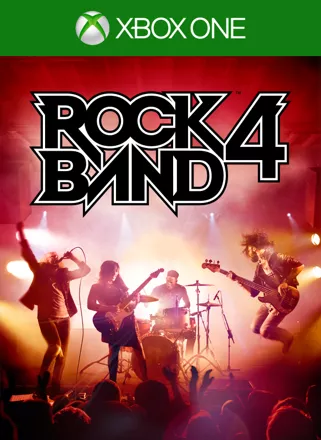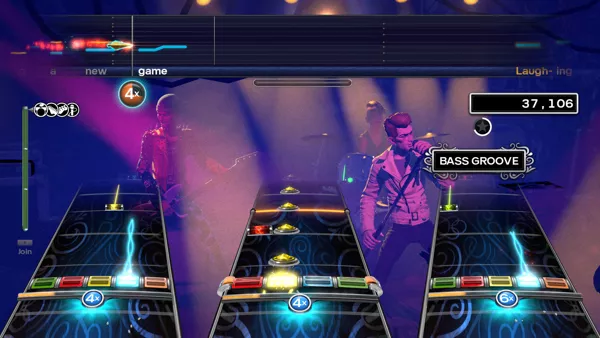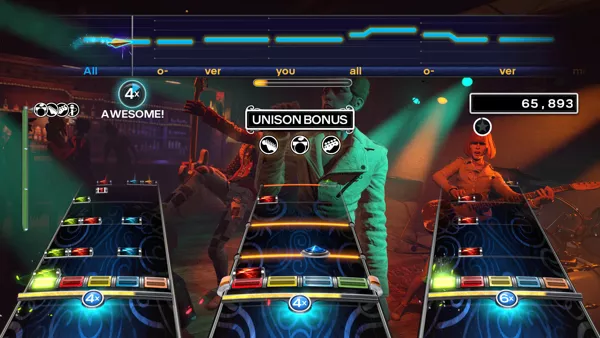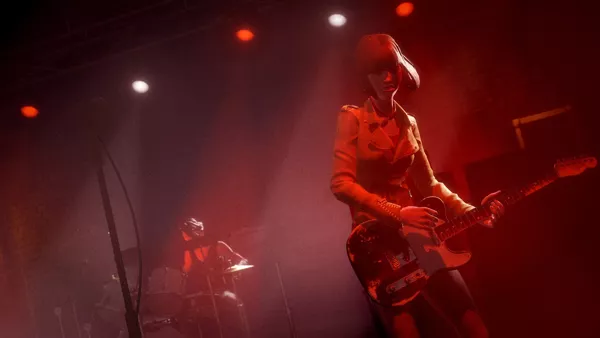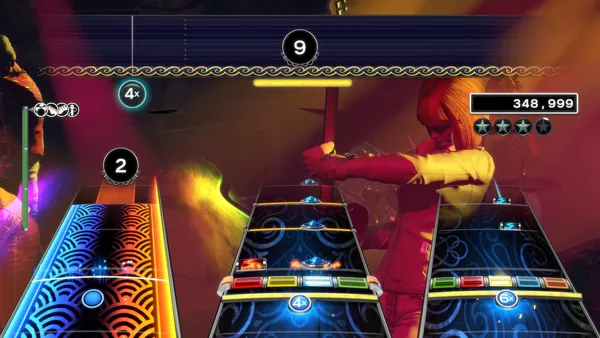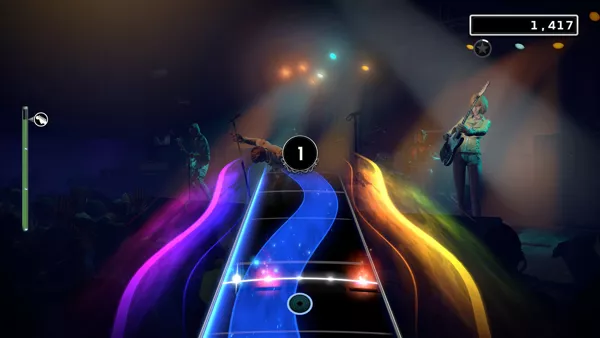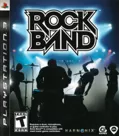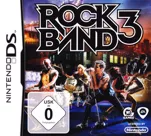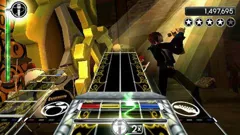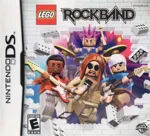Rock Band 4
Description
Rock Band 4 is the fourth game in the Rock Band series released five years after the previous main title Rock Band 3. It continues the concept of the earlier games where players simulate playing music using peripherals designed as instruments to mimic playing the lead and bass guitar and drums, and singing the vocals to songs. Unlike the contemporary Guitar Hero Live it has backwards compatibility for the instruments and content of the previous games in the same console family. The wireless guitar and drum controllers from the PS3 and Xbox 360 versions of previous Rock Bands can be used. For the PS4 this is done using the existing USB dongle and for the Xbox One with a new dongle included with the game. It is also sold as a Band-in-a-Box bundle with a wireless Fender Stratocaster guitar, a wireless drum kit, and USB microphone, or just the guitar. Two instruments introduced in Rock Band 3 are no longer supported: the Pro Guitar and the Keyboard. The new instruments are fairly similar, but have been redesigned. Like in the previous game the drum kit can be expanded with three pads that act as symbals to use in the Pro Drum mode. Songs purchased as DLC for previous versions of the game can be carried over inside the same console family free of charge granted they has been ported over to support the features of the new version of the game.
The gameplay is identical to the earlier games and the visual style is still based on animated characters and environments. One or more players use the instruments and microphone to play and sing through songs by following the cues on the screen. The score is based on the accuracy. Certain sections are marked with coloured notes. When these are completed successfully, an Overdrive meter is filled. When sufficiently full it can be activated to double the score multiplier for a short while. The base game contains 63 tracks, with both new ones and some that were previously available as DLC for earlier games.
Freestyle solos are a new feature for the game. There are sections with solos for individual instruments where there are no prompts on the screen to follow. The player is entirely free to improvise, but to score there are a few general rules to follow. Using the guitar a blue colour shows the upper buttons need to be used and an orange colour the bottom ones. There are also hints when to match the beat, when to fingertap or to only use long notes. Optionally this feature can be disabled and then a predetermined solo needs to be followed. For the drums there are now drum fills replacing the freestyle sections of the previous game. For the vocals, when playing on 'hard' or 'expert', it is possible to boost the multiplier by singing an octave higher or lower as soon as the pitch is generally correct. Like in earlier games some songs have harmonies for up to three parts.
In the main career mode a starting band is introduced who needs to make it to the top. Instead of just completing songs to progress, the game presents various options for gigs that hold certain risks and rewards, from the attendance of fans based on the chosen region to the amount of money that can be earned and the opportunities it opens for the future career. For instance, if a band mainly chooses money and plays corporate sponsored gigs, this may influence the fanbase and possible future venues. The money earned through performances can be used to customize the band's instruments and clothes. The band members can be designed as custom avatars with various options for the looks and clothes. Players can also decide to hire a stylist and choose how to travel around. Remaining overdrive and multipliers are sometimes carried over between songs. The game no longer has online multiplayer or a practice mode. There is quick play and a new mode called shows, as a series of songs broken up in sets. The songs are largely predetermined but the players can vote on them between songs or during parts of the song when their instrument is not active.
Groups +
Promos
Credits (PlayStation 4 version)
948 People (920 developers, 28 thanks) · View all
| Development Leads | |
| Creative Leads | |
| Product Managers | |
| Programming Leads | |
| Programming | |
| [ full credits ] | |
Reviews
Critics
Average score: 73% (based on 14 ratings)
Players
Average score: 4.2 out of 5 (based on 5 ratings with 1 reviews)
A mostly successful comeback tour
The Good
Freestyle guitar solos are extremely fun
* Harmony vocal parts for every song
* Vocal Freestyle is nice for singers
* Enjoyable career mode
* Auto-kick for drums
The Bad
No keyboards
* Barebones online play
* No competitive multiplayer modes
* Average setlist
* Graphics are not a major improvement over previous games
The Bottom Line
Few games convey the joy of cooperation as much as Rock Band. As a lifelong gamer, I can’t think of any other cooperative game that appeals to as wide a range of ages and skill levels as this series. A person with virtually no gaming experience whatsoever can get just as much enjoyment out of it as the hardcore gamer who needs to 100% every single song blindfolded. It’s truly one of the greatest multiplayer games ever made, alongside Mario Kart and Super Smash Bros.
It was heartbreaking when Rock Band’s developer Harmonix announced in 2013 that they were ending support for the series. I myself had invested a lot of time and money into the franchise on the Nintendo Wii, so to see it just end was one of the biggest letdowns in gaming of the past few years. Nevertheless, it was clear that it needed to hang up its guitar. The music game bubble that Harmonix had started in 2005 with Guitar Hero had burst only 5 years later. Although Rock Band 3 was perhaps the most comprehensive rhythm game ever made, it simply wasn’t enough to save the oversaturated genre from its fading cultural and commercial relevance. The market had moved on, leaving only a small handful of dedicated players in its wake.
Rock Band 3 was arguably the last console rhythm game ever made with a AAA budget and level of ambition, and as a newly independent studio there was no way Harmonix was ever going to live up to that. Instead, Rock Band 4 is all about refining the core experience of Rock Band, and serves as a “back-to-basics” reboot of the series.
Rock Band 4 has added new features for guitar, vocals, and drums (sorry bass players). Drums have what are known as “dynamic” fills, which are pre-made fills that are inserted into a song whenever the drummer’s overdrive is ready to be activated. These replace the freestyle fill lanes, though you have the option of switching back to the old fills. These kind of fell flat for me, as the rhythm and style of fills can often disrupt the flow of a song. On the easiest songs with very little activity however, these can be a lot of fun. Drums have always been my personal weakest instrument in Rock Band, as I lack the limb coordination to hit the bass pedal properly with the rest of the pads. Luckily for players like me, Harmonix also included a cheat to have the bass pedal be hit automatically, a much needed option that I can’t believe took this long to add.
Vocals have a new feature known as “Vocal Freestyle”. If you play vocals on either Hard or Expert, you have the option of singing whatever you want, with the caveat that it must be on-key with the song. This helps to make vocals more realistic, since most rock singers do not actually sing a song exactly the same way every time when playing live. However, this has the side effect of making vocals relatively easy, so if you want more of a challenge you should turn it off. You also have the option of singing along with the harmony parts of any song. This includes songs released before Rock Band 3, as dedicated fans actually went back and retroactively added harmony parts to every single Rock Band song, which were then integrated into the official charts by Harmonix. It’s a nice gesture that proves just how passionate fans are about the game.
Rock Band 4’s real standout addition is the freestyle guitar mode. Rather than stick to the script, Rock Band 4 lets you improvise your own solos. It’s simply amazing how many guitar techniques Harmonix was able to simulate using 10 buttons, a tilt sensor and a single strum bar. Not only can you play notes, chords, and licks, you can bend notes, create feedback by tilting the guitar, and even finger-tap. Plus, it finally gives those unloved solo frets at the bottom of the guitar’s neck a tangible, in-game purpose. During a song, you have different cues which tell you what kind of frets you can use and what sort of rhythms you can play, and hitting them successfully will retain the streak. Even with the issue of audio input lag making your guitar sound delayed, this is still one of the coolest experiences I’ve ever had with a rhythm game. Thankfully this is not a replacement for the original charted solos: they are still present and you can turn this feature on or off when starting a song.
Rock Band 4’s career mode is easily the best in series history. Similar to Rock Band 1 and 2, you’ll create a band which then travels to different cities, playing different gigs to earn money, fame, and experience. Rock Band 4 adds a “choose-your-own-adventure” aspect to the proceedings. At certain points in the career mode, you’ll have to make decisions between earning more fame or money,. These decisions affect how much control you have over your setlists. You could, for example, choose to tour in a minivan, or you could sign with a manager but have to play what he wants. Earning different amounts of money and fame unlocks different pieces of gear which you can use to customize your avatars.
While playing a song in career mode, you can also earn “stage presence”, which is essentially achievements for each song. For example, if you play bass, you’ll earn stage presence for keeping a long groove and up-strumming a majority of the notes. Each instrument has its own requirements for earning stage presence, so you’ll definitely want to keep them in mind as you play career mode.
Some shows allow you complete control over your setlist, while others make you play specific songs as in the prior career modes. During shows, you might have the option of voting on the next song to play. Sometimes, the game will tell you what songs you’re picking, while other times it will simply tell you a genre, year, or artist. You also get to choose to play an encore or play a fan requested song in place of what you had originally planned, which will net you further fame and experience. These little touches pull you into the experience of being a band even further than before, as you’ll be deliberating with your bandmates on what songs to play next.
Rock Band 4’s setlist is unfortunately not one of its strongest features. Part of the problem stems from Rock Band’s vast DLC library of music available. So many great songs, both classic and modern, are available to download from the in-game music store, or available in previous titles. The other problem is that Harmonix no longer has the backing of MTV and EA. Rock Band 4 tries hard to come up with a fun list, but most casual and even hardcore music fans are going to struggle with recognizing a lot of these tracks. Harmonix was at least able to secure a few big name acts for the first time in series history such as Elvis Presley and U2. but by and large this track list skews heavily towards lesser-known modern rock and indie artists. There are only 64 songs on the setlist , compared to the 80+ songs that were on the last two games, which does feel like a slight step back. Admittedly, I was pleasantly surprised by how much fun most of these tracks are to play once you get to know them. That being said, I probably would have passed on the vast majority of these tracks had they appeared as DLC in the music store.
One thing that differentiates RB4 from its predecessors is that it’s a continually evolving game. Rather than create sequel after sequel, Harmonix is instead updating the game and releasing paid expansions which add new features. The first major expansion is called “Rivals”, and it allows access to the game’s online multiplayer as well as two new modes: Rockudrama and Rivals. The former is a new career mode that’s structured like a mockumentary, complete with cheesy “Behind the Music” - style FMV cutscenes depicting the rise and fall of your virtual band. Rivals is a competitive mode where people compete with other players to earn the best scores on leaderboards.
For a next-gen only game, it’s actually kind of surprising how average Rock Band 4 looks. The series was never a visual powerhouse to begin with, but with the leap in hardware I was expecting a more noticeable jump in terms of the visuals than what we got. It’s largely the same style that was present in the earlier games, although the lighting and textures are slightly more colorful than what came before. There is also no music video venue in Rock Band 4, which was a really cool feature in RB2 and 3.
The biggest disappointment is the complete lack of keyboard support. Having the keys really helped to diversify the types of genres that were available to play, and opened up songs and artists not possible with the standard setup. Despite fan begging, Harmonix has said that keys will never make a return, since they were the least popular instrument according to online play data. That leaves Rock Band 3 as the only game in the series to have a keyboard option. What makes things even worse is that ever since the game’s release, Harmonix has continually put out songs that have little-to-no guitar and instead charted piano, horn, and synthesizer parts to the guitar controller when they could. One song I downloaded even has a harmonica solo charted to guitar. This makes the setup even less fun to play since it doesn’t feel as immersive to play non-guitar instruments on a guitar controller. I felt like some of these problems could have been solved by having keys available.
Aside from the local co-op experience, which is the best it could be aside from the lack of keys, the suite of multiplayer options is still somewhat lacking. The competitive modes (Score Duel, Tug-of-war) that were in the first two games still haven’t made a return. Online quickplay is present, but only available to those who purchase the Rivals expansion (which I did). There’s no matchmaking with random players, and you can only play with one instrument per console. This feature wasn’t even available at launch and was only recently released, so I find it unbelievably disappointing that the implementation is as barebones as it is.
In the end, Rock Band 4 pretty much exists for one reason and one reason only: to have Rock Band on the next generation of consoles. There was a ton of behind-the-scenes work involving re-licensing music, developing a new game engine, and allowing players to transfer their DLC content from their older consoles, that I think has gone under appreciated, even by the fan community. My enthusiasm for this game stems from the fact that its the return of a franchise I never thought I would ever see again. Rock Band 4 mostly succeeds in refining the core experience, even it is so heavily stripped back in some ways that it feels like a slight step backward for the series.
PlayStation 4 · by krisko6 (814) · 2017
Analytics
Related Sites +
-
Wikipedia: Rock Band 4
Article about the game in the open encyclopedia
Identifiers +
Contribute
Are you familiar with this game? Help document and preserve this entry in video game history! If your contribution is approved, you will earn points and be credited as a contributor.
Contributors to this Entry
Game added by Sciere.
Additional contributors: Kennyannydenny.
Game added October 23, 2015. Last modified December 22, 2024.


